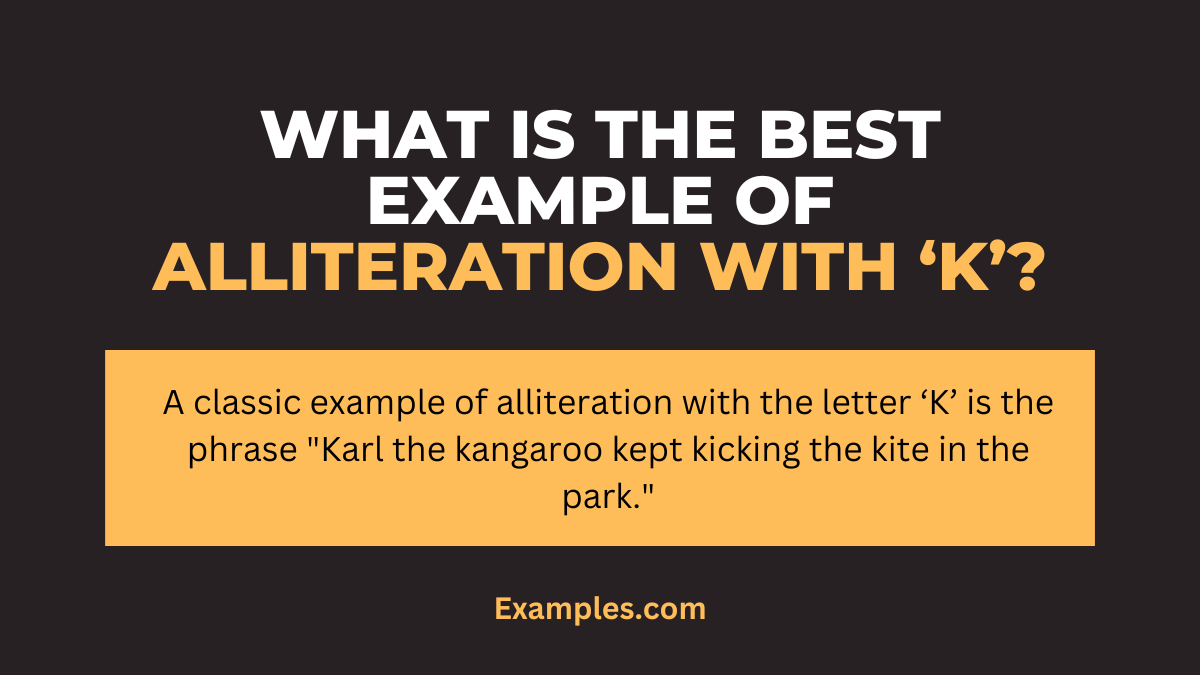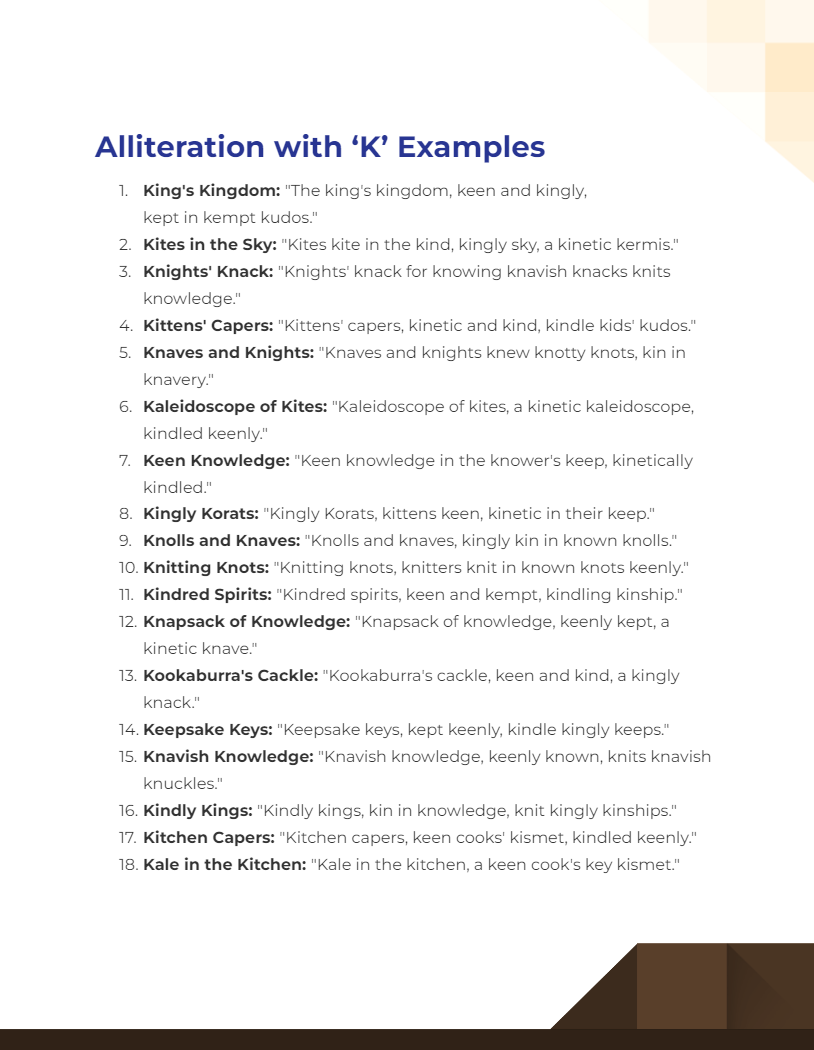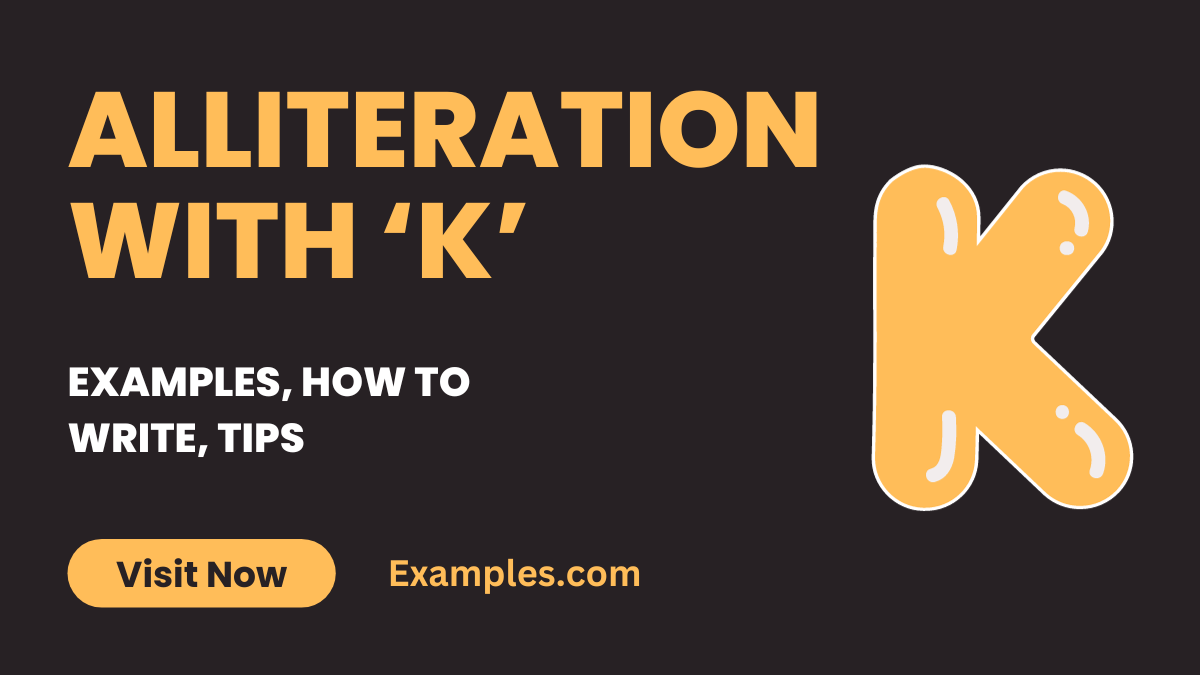19+ Alliteration with K Examples
Alliteration with ‘K’ is a linguistic art that brings a unique rhythm and musicality to language. By repeatedly using words that start with the letter ‘K’ at the beginning of closely connected words, writers can create a distinct sound pattern that captures readers’ attention. This alliterative literature technique is often used in poetry, prose, and advertising to enhance the lyrical quality of language. For example, a sentence like “Kevin’s kite kissed the keen sky” uses alliteration to create a vivid and imaginative picture. In this guide, we’ll explore various examples of alliteration with ‘K,’ provide tips on how to write effectively using this device, and highlight its impact in different forms of writing.
Download Alliteration with 'K' Examples
Download Alliteration with 'A' to 'Z' Examples
What is the Best Example of Alliteration with ‘K’?

Example: A classic example of alliteration with the letter ‘K’ is the phrase “Karl the kangaroo kept kicking the kite in the park.”
Meaning: Alliteration is a literary device in which consecutive words in a sentence or phrase begin with the same consonant sound, creating a rhythmic and memorable pattern. In the example “Karl the kangaroo kept kicking the kite in the park,” the repeated ‘K’ sound at the beginning of multiple words adds a playful and rhythmic quality to the sentence. This technique is often used in poetry, literature, and tongue twisters to create a pleasing and engaging effect for readers or listeners. In this specific example, the easy alliteration emphasizes the actions of Karl and the playful scene in the park.
20 Alliteration with ‘K’ Examples

Download Alliteration with 'K' Examples in PDF
Alliteration with the letter ‘K’ knits together a kaleidoscope of sounds that range from keenly crisp to kinetically charged. The ‘K’ sound, known for its clear and often sharp auditory effect, offers a wealth of possibilities for both easy and hard alliteration examples. This type of alliteration is particularly effective in alliteration in rhymes, where the repetition of the ‘K’ sound can add a rhythmic and engaging dimension to verses. Here are 20 unique examples of alliteration with ‘K’, each accompanied by a creative rhyme title that captures the essence of the phrase.
- King’s Kingdom: “The king’s kingdom, keen and kingly, kept in kempt kudos.”
- Kites in the Sky: “Kites kite in the kind, kingly sky, a kinetic kermis.”
- Knights’ Knack: “Knights’ knack for knowing knavish knacks knits knowledge.”
- Kittens’ Capers: “Kittens’ capers, kinetic and kind, kindle kids’ kudos.”
- Knaves and Knights: “Knaves and knights knew knotty knots, kin in knavery.”
- Kaleidoscope of Kites: “Kaleidoscope of kites, a kinetic kaleidoscope, kindled keenly.”
- Keen Knowledge: “Keen knowledge in the knower’s keep, kinetically kindled.”
- Kingly Korats: “Kingly Korats, kittens keen, kinetic in their keep.”
- Knolls and Knaves: “Knolls and knaves, kingly kin in known knolls.”
- Knitting Knots: “Knitting knots, knitters knit in known knots keenly.”
- Kindred Spirits: “Kindred spirits, keen and kempt, kindling kinship.”
- Knapsack of Knowledge: “Knapsack of knowledge, keenly kept, a kinetic knave.”
- Kookaburra’s Cackle: “Kookaburra’s cackle, keen and kind, a kingly knack.”
- Keepsake Keys: “Keepsake keys, kept keenly, kindle kingly keeps.”
- Knavish Knowledge: “Knavish knowledge, keenly known, knits knavish knuckles.”
- Kindly Kings: “Kindly kings, kin in knowledge, knit kingly kinships.”
- Kitchen Capers: “Kitchen capers, keen cooks’ kismet, kindled keenly.”
- Kale in the Kitchen: “Kale in the kitchen, a keen cook’s key kismet.”
- Knack for Knowledge: “Knack for knowledge, keenly known, a kin’s keen kismet.”
- Kites on the Knoll: “Kites on the knoll, keenly kiting in the kempt breeze.”
Alliteration Sentence Examples with ‘K’
Alliteration sentence examples with ‘K’ often convey a crisp, clear sound, adding a rhythmic and often playful quality to the text. The distinct ‘K’ sound is versatile and can be used to create various effects, from light-heartedness to intensity. Such alliteration sentence examples can be found in various forms of writing, including alliteration in poems, songs, and even movies. Here are three examples:
- “Kevin’s kite kissed the kingly sky, keeping keen kids kaptured.”
- “Kara’s kitchen was known for its kooky, kaleidoscopic knick-knacks.”
- “Karl’s keen kayaking skills were known across the kingdom.”
Alliteration Examples with ‘K’ Words
Alliteration examples with ‘K’ words demonstrate the impact of this consonant in creating rhythmically engaging phrases. This form of alliteration is utilized for its energetic quality in alliteration in songs, creating memorable lines. Here are three examples:
- “Knights known for knavery knelt, knowing the king’s kindness.”
- “Kendra’s kitten, a kaleidoscopic kale, kept kicking knavishly.”
- “Keenly keeping kites aloft, kids kavorted in the knoll.”
Alliteration Examples with ‘K’ Sound
The ‘K’ sound in alliteration can produce a variety of effects, ranging from playful and light to strong and resonant. These examples demonstrate the different ways the ‘K’ sound can be employed in alliterative structures. Here are three examples:
- “Kara keenly kicked the kaleidoscopic kite into the keen wind.”
- “Klara’s kitchen knick-knacks knocked in the kind breeze.”
- “Knights’ kin kicked kegs of kumquats at the karnival.”
Alliteration Poem with ‘K’
An alliteration poem with ‘K’ uses the repetitive ‘K’ sound to create a rhythmic and engaging poetic experience. Alliteration in poems, especially with the ‘K’ sound, adds a unique lyrical quality. Here are three examples:
- “King’s kite, in the sky so high, / Kisses clouds as it flies by.”
- “Knights and knaves in the kingdom’s keep, / Kept their vows, deep and steep.”
- “Kittens in the kitchen play, / Keeping kalm in their own way.”
Alliteration Beginning with ‘K’
Alliteration beginning with ‘K’ sets a distinctive tone and rhythm in a phrase, often creating a memorable impact. This form of alliteration is found in various artistic expressions, including alliteration in movies, adding a lyrical or dramatic flair. Here are three examples:
- “Kendra’s kaleidoscopic kites kindled kids’ keen imaginations.”
- “Klara’s kin knew knacks of knitting kites and kimonos.”
- “Kevin’s kayak knifed through the kinetic, kelp-filled waters.”
How to Write Alliteration with ‘K’?
Writing alliteration with the letter ‘K’ involves creating phrases or sentences where the ‘K’ sound is repeated at the beginning of closely connected words. This consonantal alliteration can add a sharp, crisp sound to writing, making it more impactful and memorable. It’s a technique used in various contexts, including alliteration figurative language exercises and in creating alliteration for first grade. Here’s a guide to creating effective alliteration with ‘K’:
- Identify the ‘K’ Sound: Understand the ‘K’ sound, which is clear and pronounced. It’s important to distinguish it from similar sounds for effective alliteration.
- Choose a Theme: Select a theme or concept. This aids in finding ‘K’ words that are relevant and appropriate for your context, such as creating famous alliteration examples or content for alliteration for first grade.
- Brainstorm ‘K’ Words: Make a list of words starting with the ‘K’ sound. Consider a variety of words, including nouns, verbs, and adjectives, to enhance your alliteration.
- Formulate Your Phrase or Sentence: Construct a sentence or phrase using your chosen ‘K’ words. The alliteration should feel natural and enhance the rhythm of the sentence.
- Read Aloud for Rhythm: The effectiveness of alliteration is best judged audibly. Read your sentence aloud to ensure it flows well and the ‘K’ sound is pronounced clearly.
- Revise for Clarity and Impact: Ensure your alliterative phrase is clear and contributes to your overall message. The goal is to use alliteration to enhance, not complicate, the understanding of the text.
- Apply in Various Contexts: Whether it’s in alliteration with answers, in educational settings like alliteration for first grade, or in creative writing, adapt your use of ‘K’ alliteration to suit the purpose and audience.
Tips for Using Alliteration with ‘K’
Here are the Tips for Using Alliteration with ‘K’:
- Use Sparingly: While alliteration can add style and rhythm, overuse can detract from your main message. Use it to emphasize key points or add flair.
- Maintain Clarity: Your primary goal is to convey a message clearly. Alliteration should complement, not confuse, your narrative.
- Vary Word Length and Complexity: Incorporate a mix of short and long ‘K’ words, as well as simple and complex words, to maintain interest, especially in alliteration figurative language.
- Consider the Mood: The ‘K’ sound can be sharp and commanding or light and playful. Match the mood of your alliteration with the overall tone of your text.
- Read and Revise: Reading your work aloud helps you assess the rhythm and flow. Make adjustments to ensure the alliteration enhances the text.
- Appropriate for Audience: Tailor your alliteration to your audience. For instance, alliteration for first grade should be simpler and more playful than alliteration for adults.
- Explore Different Forms: Try ‘K’ alliteration in various forms of writing, from poetry and stories to advertising and academic work, to understand its effect.
Remember, the key to effective alliteration with ‘K’ is balancing creativity with readability, ensuring that the alliterative phrases add value to your writing.
What are the Alliteration with ‘K’ for Kids?
Alliteration with ‘K’ for kids involves creating phrases or sentences where the ‘K’ sound is repeated, typically in a fun and engaging manner. This approach is particularly effective in making language learning enjoyable for children. The repetitive ‘K’ sound can help with phonetic awareness and can be a part of great alliteration examples used in educational content. For alliteration for kids, the phrases are usually simple, rhythmic, and easy to remember. Examples include:
- “Kenny the kangaroo likes to kick kites in the kingdom.”
- “Katie’s kitten keeps knocking knick-knacks off the kitchen counter.”
- “Kevin the koala knew how to climb the tallest kiwi tree.”
These examples are designed to be catchy and memorable, aiding in language development and literacy skills among children.
What is the Effect of ‘K’ Letter in Alliteration?
The effect of the ‘K’ letter in alliteration is to create a sharp, clear sound that adds a distinctive rhythm and emphasis to a phrase. The ‘K’ sound is often perceived as strong and commanding, making it effective in drawing attention to certain parts of a text. In literature, ‘K’ alliteration can be used to enhance the musicality of language, add emphasis, and create mood. This effect is prominent in great alliteration examples across various forms of literature, including alliteration in poems, songs, and prose. The ‘K’ sound is versatile and can be used in educational settings for alliteration for students, as well as in more sophisticated contexts in alliteration for adults.
What is the Alliteration ‘K’ Type of?
Alliteration with the letter ‘K’ is a type of consonantal alliteration, where the consonant sound at the beginning of adjacent or closely connected words is repeated. This type of alliteration is known for its ability to add a rhythmic and sometimes forceful quality to language. ‘K’ alliteration is a popular literary device used across various forms of writing, from creative works to educational materials. It’s often used in alliteration and assonance exercises to explore the sonic qualities of language. The ‘K’ type of alliteration can create different effects, from playful and light in alliteration for kids to more serious and impactful in alliteration for adults and students, depending on the context and the words chosen.


